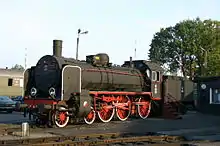| Ok1 | |||||||||||||||||||||||||||||||||||||||
|---|---|---|---|---|---|---|---|---|---|---|---|---|---|---|---|---|---|---|---|---|---|---|---|---|---|---|---|---|---|---|---|---|---|---|---|---|---|---|---|
%252C_Ok1-359_(SIK_03-035875).jpg.webp) Ok1-359 in 1989 | |||||||||||||||||||||||||||||||||||||||
| |||||||||||||||||||||||||||||||||||||||
| |||||||||||||||||||||||||||||||||||||||
| |||||||||||||||||||||||||||||||||||||||
Ok1 is the Polish designation of a Prussian steam locomotive, the Prussian P 8, used on Polish State Railways. Production of the P 8 lasted from 1908 until 1928 and this locomotive was used on practically all European railway lines.
After the end of World War I, 192 Class P 8 engines were handed over as a reparation to Poland, including two machines for Free City of Danzig, where they were re-designated as Class Ok1 locomotives (numbers: Ok1-1 to Ok1-190 and Ok1-1Dz and 2Dz for Danzig machines).[1] Since the class was considered successful, further 65 locomotives were built in Germany at Polish order in 1922-1923 (designated Ok1-201 to 265).[1]
.jpg.webp)

During World War II all the locomotives were captured by the Germans or Soviets and most were pressed into the German Railways. After the war, along with new war reparations, Poland received 429 locomotives P 8 (numbers Ok1-1 to 429), what made it by far the most numerous passenger locomotive in the country.[1] They were used until the late 1970s - last locomotive was withdrawn from line service in 1981.[1] A few engines were preserved, including Ok1-359 (see the photograph), which is stabled at the Wolsztyn museum.
See also
References
- Terczyński, Paweł (2003). Atlas parowozów [Steam locomotives' atlas] (in Polish). Poznań. p. 56. ISBN 83-901902-8-1.
{{cite book}}: CS1 maint: location missing publisher (link)
External links
- "Article on the vintage Ok1-359". Retrieved February 10, 2006.